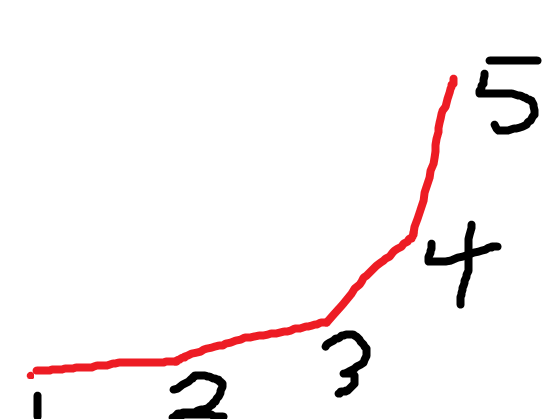HDU3507Print Article (斜率优化DP)
One day Zero want to print an article which has N words, and each word i has a cost Ci to be printed. Also, Zero know that print k words in one line will cost
M is a const number.
Now Zero want to know the minimum cost in order to arrange the article perfectly.
InputThere are many test cases. For each test case, There are two numbers N and M in the first line (0 ≤ n ≤ 500000, 0 ≤ M ≤ 1000). Then, there are N numbers in the next 2 to N + 1 lines. Input are terminated by EOF.OutputA single number, meaning the mininum cost to print the article.Sample Input
5 5 5 9 5 7 5
Sample Output
230
应该是初步get了,由于以前看到的博主的配图和用语有误,让人再混沌之中浮尸了好久,头疼,应该是这样的图。
wa,我自己画的,将就辣。

开始学的时候感觉好抽象啊,还特意去学了瞎‘凸包’专题,QwQ,这里主要是解释一下‘为什么’。
初学感悟:
零:我们把线段的两个端点叫做点对,把dp[j]+(sum[i]-sum[j])^2取得最小的是j叫做i的最优点。
一:一对点对里,前面的点和后面的点的优劣关系由sum i决定,但是删去前劣后优的点后,剩下的就是前由后劣,得到i时的队首最优。
Ω,本来的点对满足k=(y1-y2)/(x1-x2) > sum[i],由于sum i是递增的,后面这个不等关系可能会改变。即此时(i==n时)队首是最优点,但是当i>n时,可能存在k<sum[i],这也是为什么我们需要每个i维护队首元素,使得队首是最优点。
二:我们维护的是一个斜率上升的图形,1,2,3,4代表的是队列里的点,求dp i时有4步:
α, 对队首:斜率k(1,2)和sum i 的关系不再得到满足,说明对于i点,队首1已经不如队首2优,抛弃1,依此后推...
β, dp i= dp q[top]+...
γ, 对队尾:具体的如果我们要加入一点5,如果斜率k(4,5)<k(3,4),4点被抛弃:不等式(yj-yk)/(xj-xk) <= sum[i],由于sum i递增,此时小于等于,即删去的点对i不会最优,对后面的i+更不会...
ε, i入队尾,由于删去γ中不满足的点后,加入后满足图像斜率依旧上升。
三:为什么i的最优值在队首取得?
ζ, 见一,删去前劣后优的点后,剩下的就是前由后劣,队首为最优点。
四:注意整理中要考虑下正负,涉及到不等号的方向,当然此题毋须多虑。
θ, 把除法转化成乘法;注意符号。
(写法是左开右闭)
#include<cstdio> #include<cstdlib> #include<iostream> #include<algorithm> #include<cstring> using namespace std; const int maxn=500010; int dp[maxn],sum[maxn],q[maxn]; int n,m; int getdp(int i,int j) { return dp[j]+(sum[i]-sum[j])*(sum[i]-sum[j])+m; } int getdy(int i,int j) { return dp[i]+sum[i]*sum[i]-dp[j]-sum[j]*sum[j]; } int getdx(int i,int j) { return 2*(sum[i]-sum[j]); } int main() { int i,j,n,head,tail; while(~scanf("%d%d",&n,&m)) { for(i=1;i<=n;i++) scanf("%d",&sum[i]); for(i=1;i<=n;i++) sum[i]+=sum[i-1]; head=tail=1;q[1]=0; for(i=1;i<=n;i++){ while(head<tail&&(getdy(q[head+1],q[head])<=sum[i]*getdx(q[head+1],q[head]))) head++; dp[i]=getdp(i,q[head]); while(head<tail&&(getdy(i,q[tail])*getdx(i,q[tail-1])<=(getdy(i,q[tail-1])*getdx(i,q[tail])))) tail--; q[++tail]=i; } printf("%d\n",dp[n]); } return 0; }



